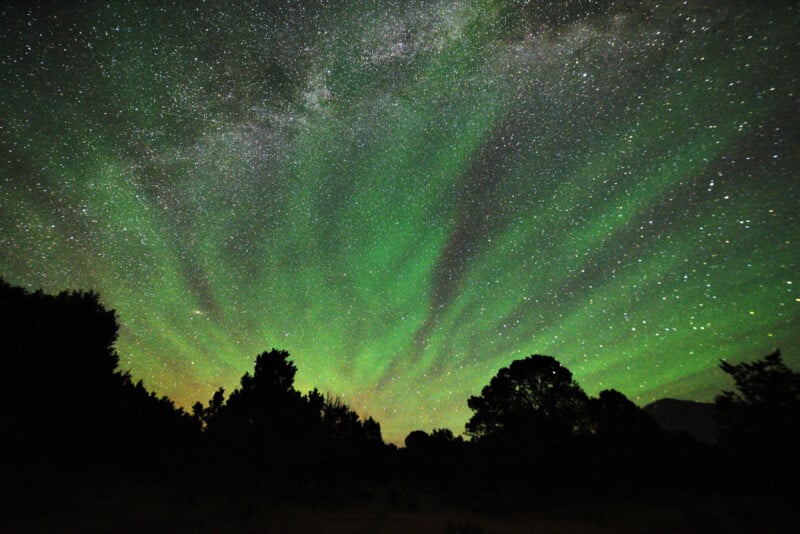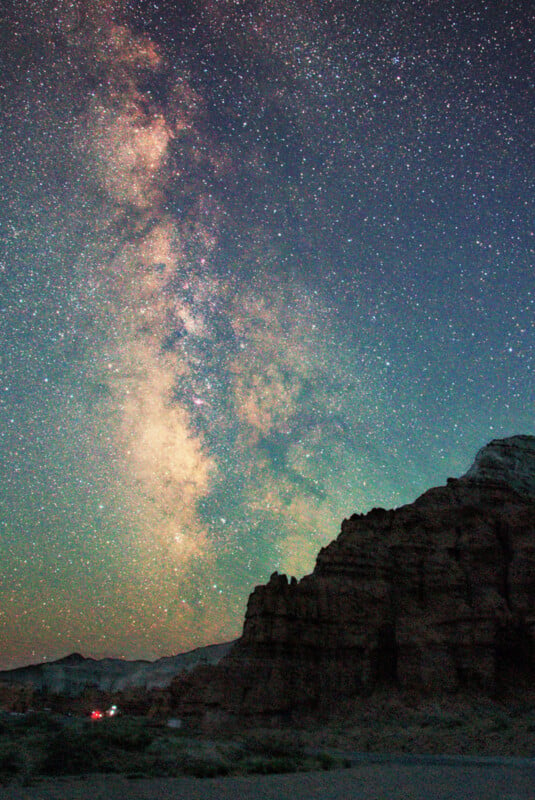Photographer Captures Beautiful Aurora-Like ‘Airglow’ in the Night Sky

Colorado-based photographer Aaron Watson captured an incredible photo of vibrant green streaks in the night sky near his home in the West Elk Mountains late on June 21 and early in the morning on June 22.
At first, the fascinating display looked like the northern lights. However, Watson saw airglow, which is a different, although related phenomenon.
“Airglow occurs when atoms and molecules in the upper atmosphere, excited by sunlight, emit light to shed their excess energy. Or, it can happen when atoms and molecules that have been ionized by sunlight with and capture a free electron. In both cases, they eject a particle of light — called a photon — in order to relax again,” explains NASA.
However, unlike auroral displays, which are episodic events often concentrated near the Earth’s poles, airglow is constant and surrounds the entire planet.
“[Airglow] is similar to auroras, but where auroras are driven by high-energy particles originating from the solar wind, airglow is energized by ordinary, day-to-day solar radiation,” adds NASA.

When Spaceweather covered Watson’s airglow photos last week, it explained that while airglow and auroral activity are separate, increased solar activity is boosting airglow. Spaceweather explains that any photographer in a dark enough area can pick up faint airglow, although the airglow Watson saw is especially dramatic.
He often sees airglow in his area, although Watson tells PetaPixel that he has never seen anything like the airglow on display as June 21 ticked over to June 22.
It has been a good year for night photography so far for Watson. He has seen the northern lights twice already this year, the first of which was mostly a reddish band, a stable auroral red (SAR) emission, and the other a more “traditional aurora with deep pink and red to the north.”
“I love being out at night under the dark and starry skies and particularly watching the celestial bodies rise and set along the horizon. I started taking photos of the moon, but recently have been getting more into long exposure nightscapes, particularly Milky Way photos with natural settings like mountains, flowers, or trees in the foreground, but also photos of clusters and conjunctions,” Watson says.
“The best, though, is capturing the transient phenomena like light pillars, auroras, and these airglow photos. I am pretty new to long exposure photography and working on a shoestring setup, but I have good luck and a strong night sense, and probably most importantly I live in an area with minimal light pollution and artificial skyglow so it’s easier to notice and capture the unexpected and fleeting moments.”

His strong night sense helped Watson spot the incredible airglow, which does not look quite the same to the naked eye as it does in Watson’s photos.
“I was looking through my telescope and as my eyes adapted to the dark I started to notice what looked like thin high clouds, but they were glowing, they had a light of their own — a white glow. Because there’s only a little light pollution where I live, usually clouds are darker, so the glowing was my first clue. Then I noticed the rays, they weren’t random cloud shapes floating along, I could see the ripples with my naked eye. At that point, I knew I needed to get the camera. Once I had the 25-second exposure, I could see the intense green in the playback screen and was like, ‘Wow that’s neat!'” Watson tells PetaPixel.
Watson captures night sky photos with a Nikon D750 with a Rokinon 14mm f/2.8 lens. He shot at f/4 and ISO 6400 and says he performed a bit of processing in the Photos app on macOS to enhance the exposure and contrast.

Much love to my telescope, 12″ dob. Nothing beats being out there under a dark and starry night sky. It’s like deep diving into the universe,” writes Watson on Facebook. | © Aaron Watson / Skies Alive Photography
As Spaceweather notes, there was no auroral activity on June 21st or 22nd, and airglow does not require solar activity. However, the website explains that there is a connection between the intensity of airglow and the solar cycle.
The solar cycle has been increasing in intensity lately, with some recent solar storms leading to beautiful auroral displays in extremely unusual locations, including places as far south as New Mexico. Other photographers have been treated to wonderful displays in Death Valley.
Live Science writes, “Experts recently revealed to Live Science that the upcoming peak of solar activity, which was due to arrive in 2025 and be relatively weak compared with historic past peaks, may actually arrive as early as the end of 2023 and be more active than previously expected. The sight of such vibrant airglow further supports this hypothesis.
“Solar activity boosts airglow by heating the upper atmosphere,” says space scientist Scott Bailey of Virginia Tech. “Warmer air causes more collisions and, thus, more green light to emerge. This is why green airglow tends to be most intense around Solar Max.”
Bailey explains that two forms of oxygen mix in a layer of air about 95 kilometers (59 miles) above Earth’s surface. Molecular oxygen (O2) and atomic oxygen (O) are abundant in this atmospheric zone, and the O2 collides with O, which is reactive, and the atoms get excited. As the atoms relax, they emit green photons.
Colors can be different depending on where excited atoms reside in the atmosphere.
“Each atmospheric gas has its own favored airglow color depending on the gas, altitude region, and excitation process, so you can use airglow to study different layers of the atmosphere,” says Doug Rowland, an astrophysicist at NASA’s Goddard Space Flight Center in Greenbelt, Maryland. “We’re not studying airglow per se, but using it as a diagnostic.”
“Airglow carries information on the upper atmosphere’s temperature, density, and composition, but it also helps us trace how particles move through the region itself. Vast, high-altitude winds sweep through the ionosphere, pushing its contents around the globe — and airglow’s subtle dance follows their lead, highlighting global patterns,” writes NASA.
Watson’s airglow photos are not only beautiful, but they also offer essential insight into the state of the upper atmosphere.
While much is understood about the ionosphere, it is extremely complicated, and some of its characteristics remain mysterious. To help uncover key details about the ionosphere and the overall relationship between the Sun and Earth, NASA is funding five experiments ahead of next year’s total solar eclipse.

More of Aaron Watson’s night sky photography is available on Facebook and Instagram.
Image credits: Aaron Watson / Skies Alive Photography